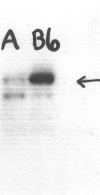Abstract
The probability that a mouse develops a pulmonary tumor, as well as the structure of that tumor, are dependent on several genes. Three pulmonary adenoma susceptibility (pas) genes predispose some inbred strains to develop lung tumors, even in the absence of carcinogen exposure, and cause others to be resistant. One pas gene is K-ras, which may also be overexpressed in these tumors in a mutated form capable of transforming cells. Mice with activated Ha-ras transgenes override the resistant pas alleles and are born with lung cancer. Susceptible strains have a higher turnover rate of alveolar type II and bronchiolar Clara cells, those cells from which lung tumors arise, than more resistant strains. A high precursor cell turnover rate correlates with a propensity to neoplasia in other animal models as well, possibly due to low concentrations of endogenous growth regulatory molecules such as corticosterone and protein kinase C (PKC). Neoplastic lung epithelial cells are relatively resistant to glucocorticoids and have low PKC levels. A set of genes other than the pas genes governs the response to tumor modulation by butylated hydroxytoluene (BHT). The genes that determine whether lung tumor multiplicity is enhanced by chronic BHT exposure may regulate the ability to hydroxylate BHT at a tert-butyl position to form BHT-OH, a metabolite with greater tumor-promoting potency than BHT. Inbred and recombinant inbred strain variations in adenoma growth patterns indicate that another set of genes, which we have designated pah for pulmonary adenoma histogenesis, may determine which cell type becomes neoplastic and whether adenomas will undergo malignant conversion.
Full text
PDF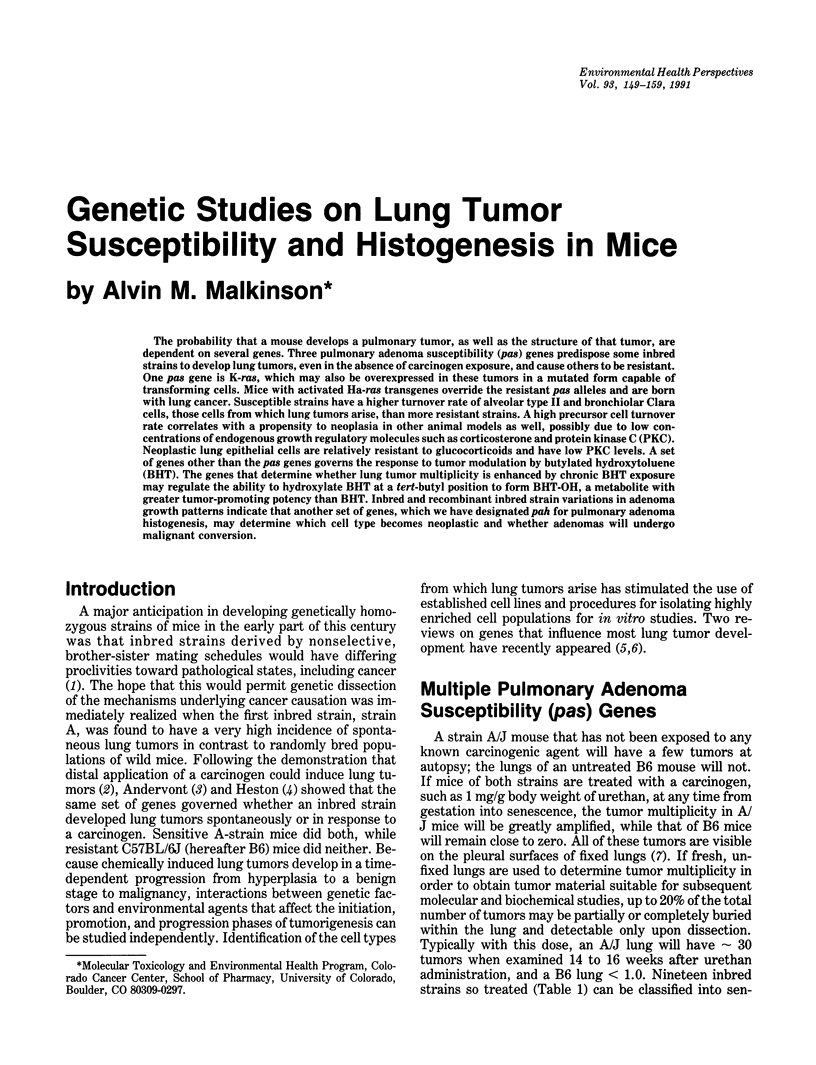
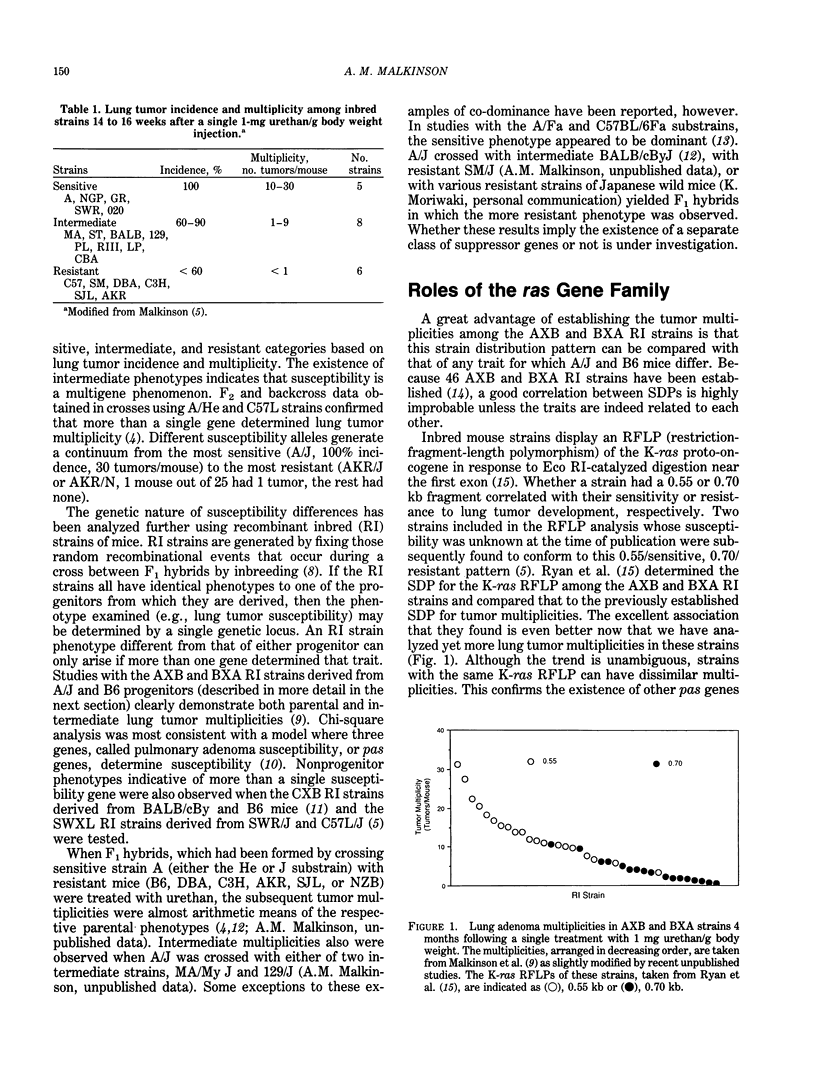
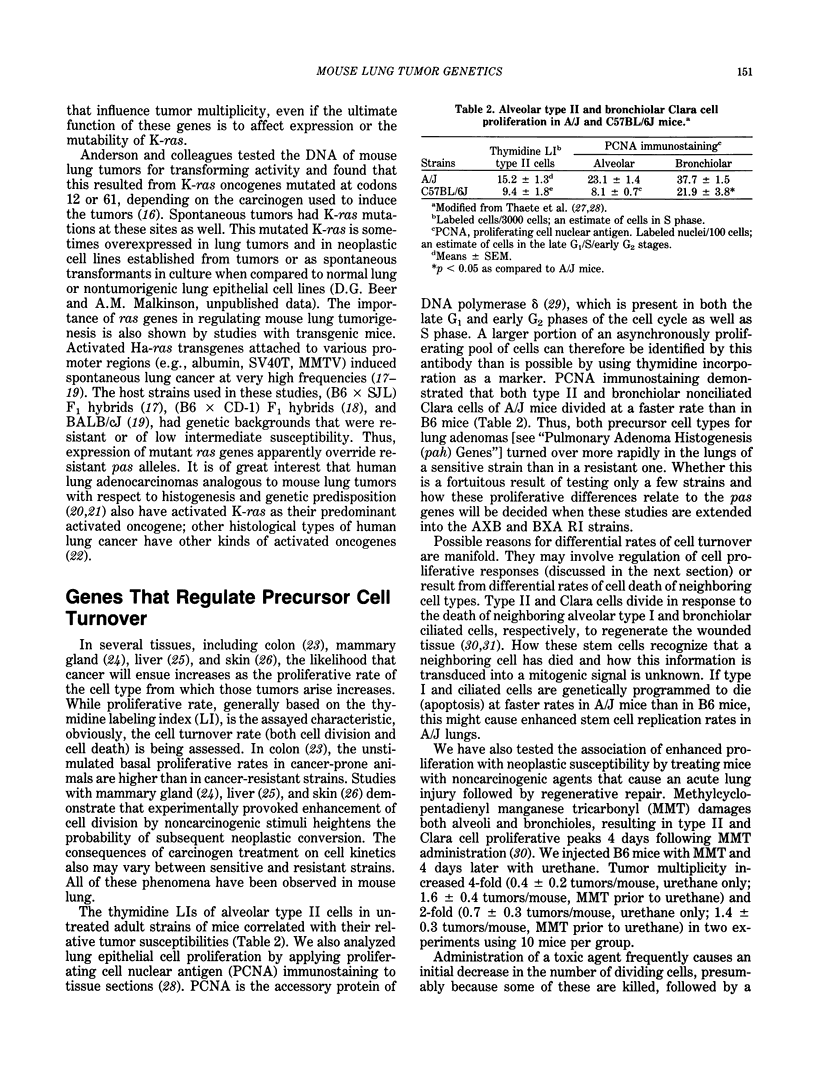
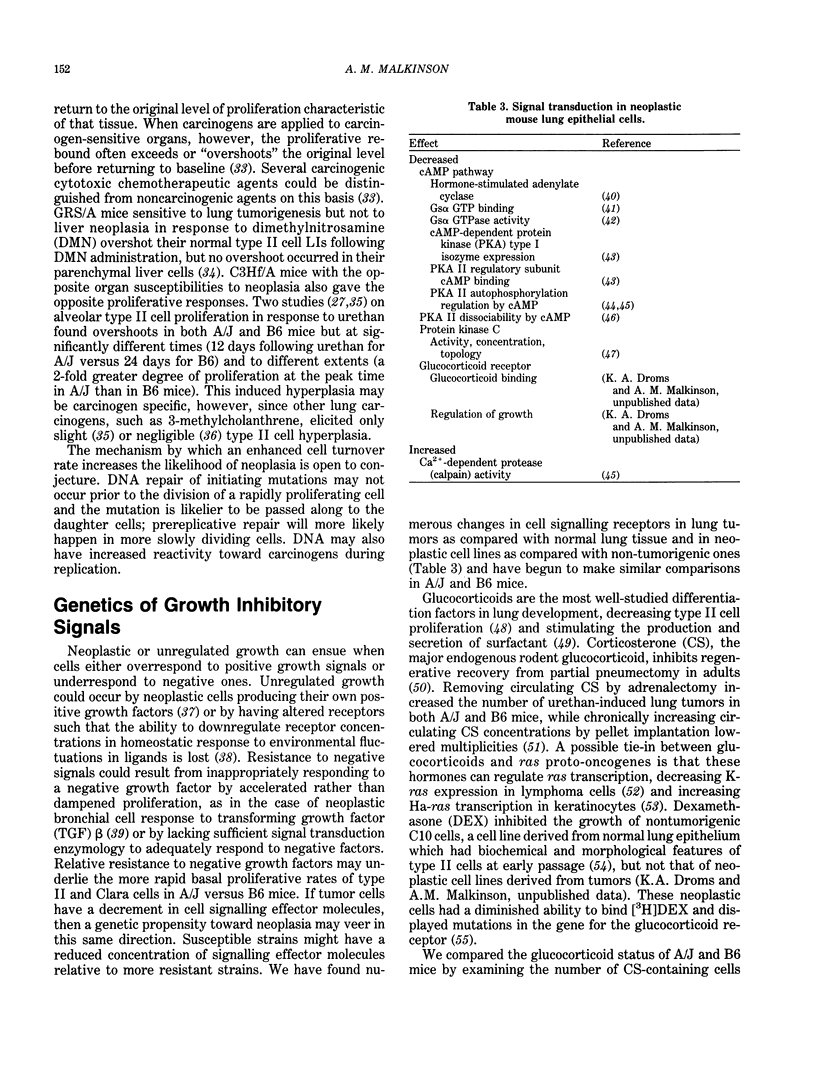
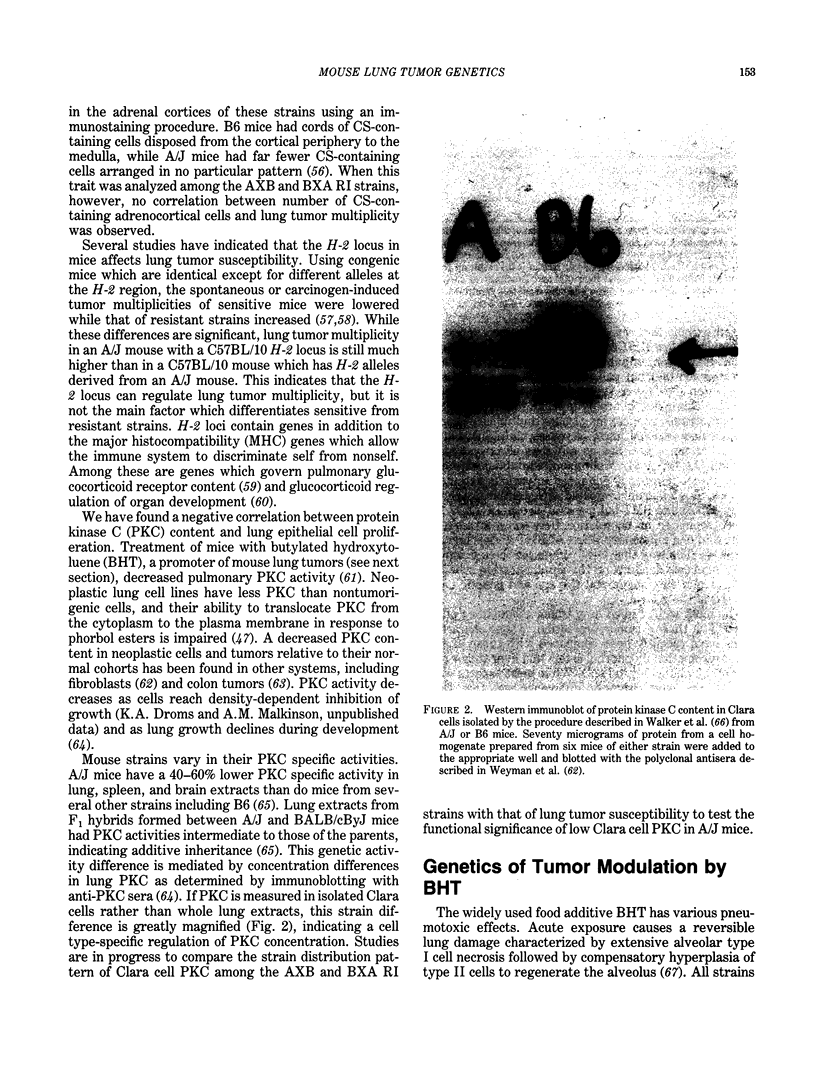
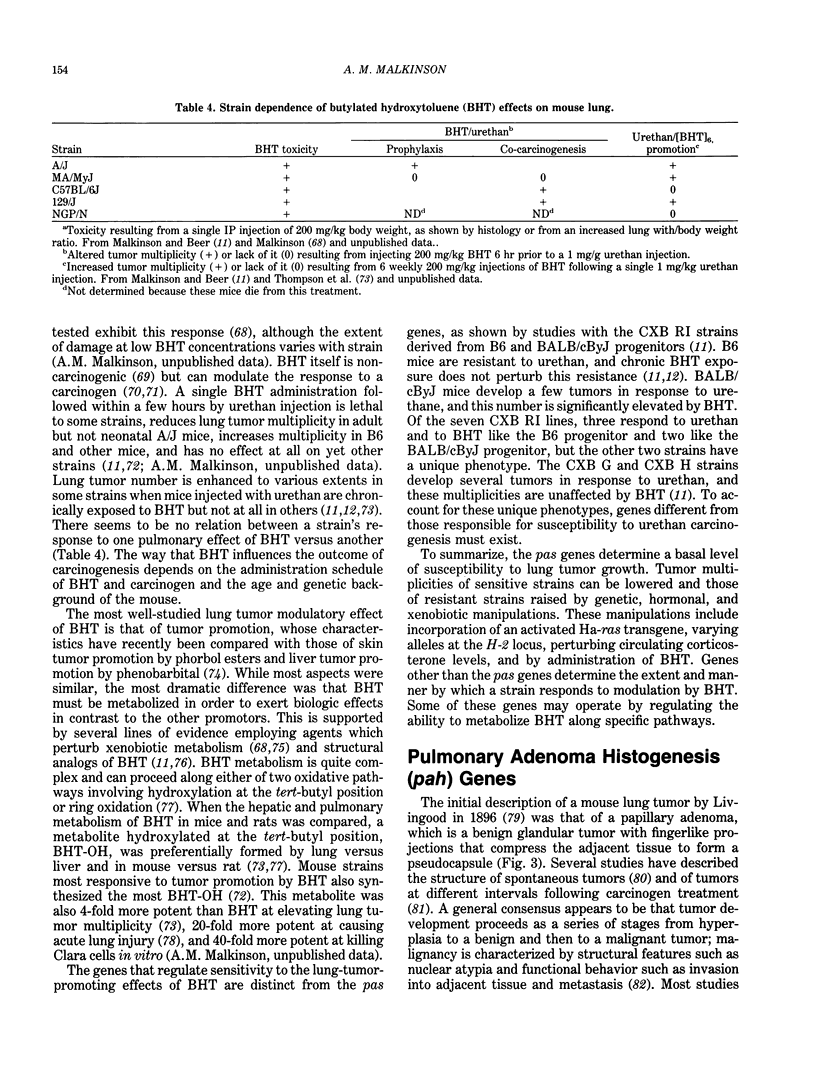
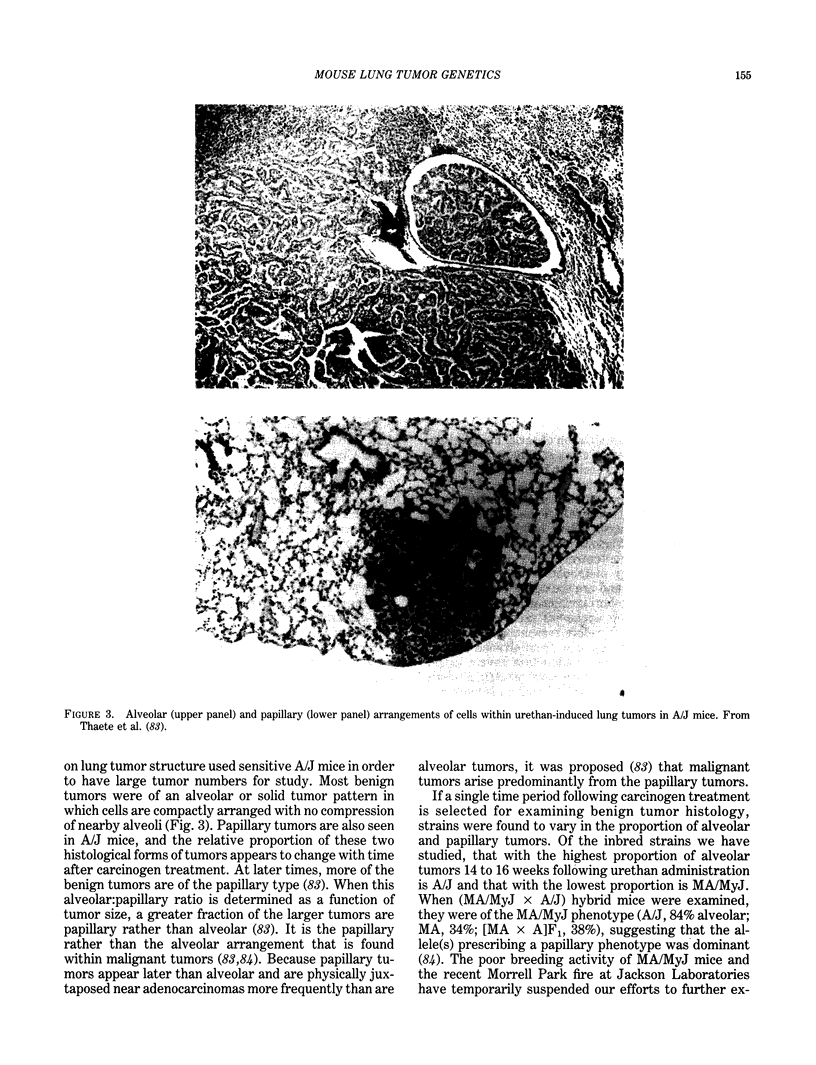
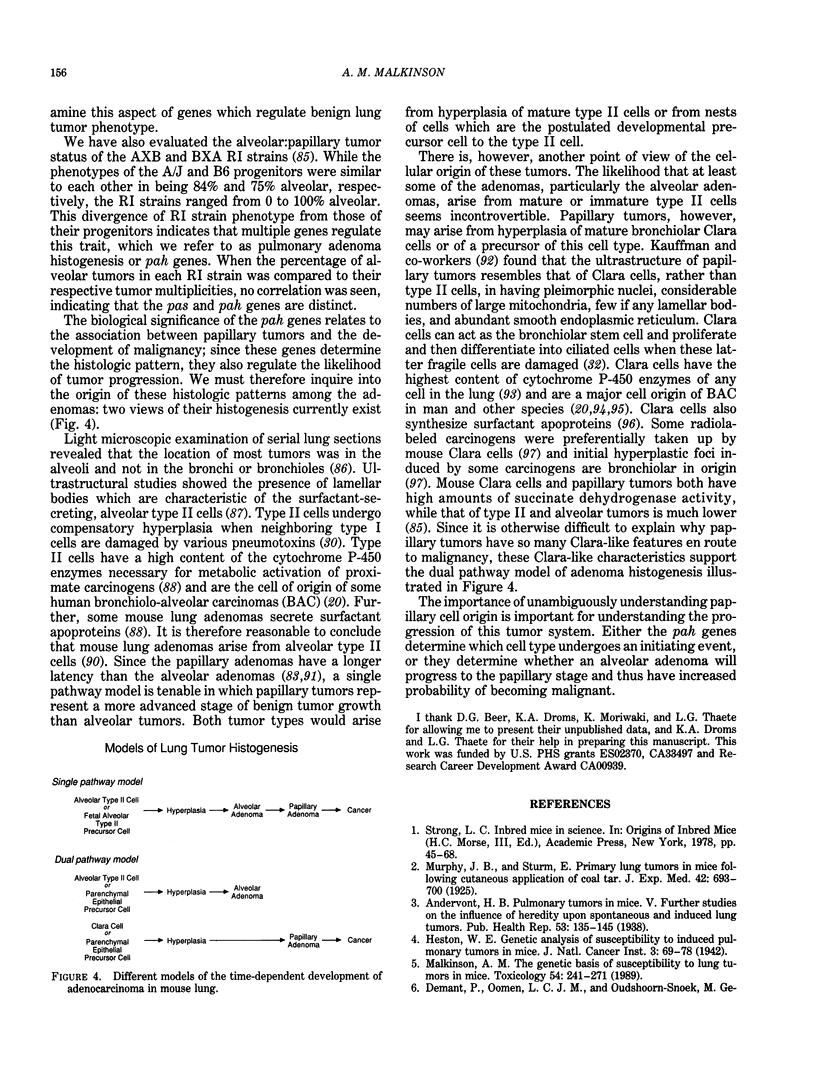
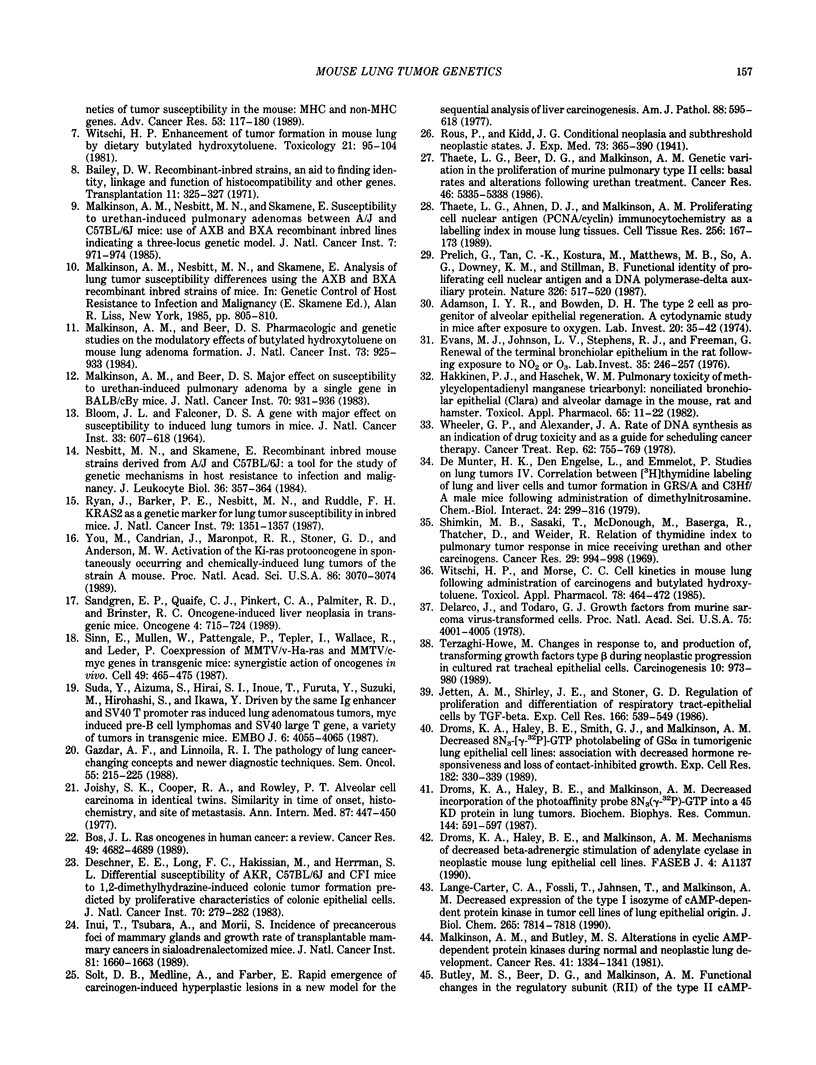
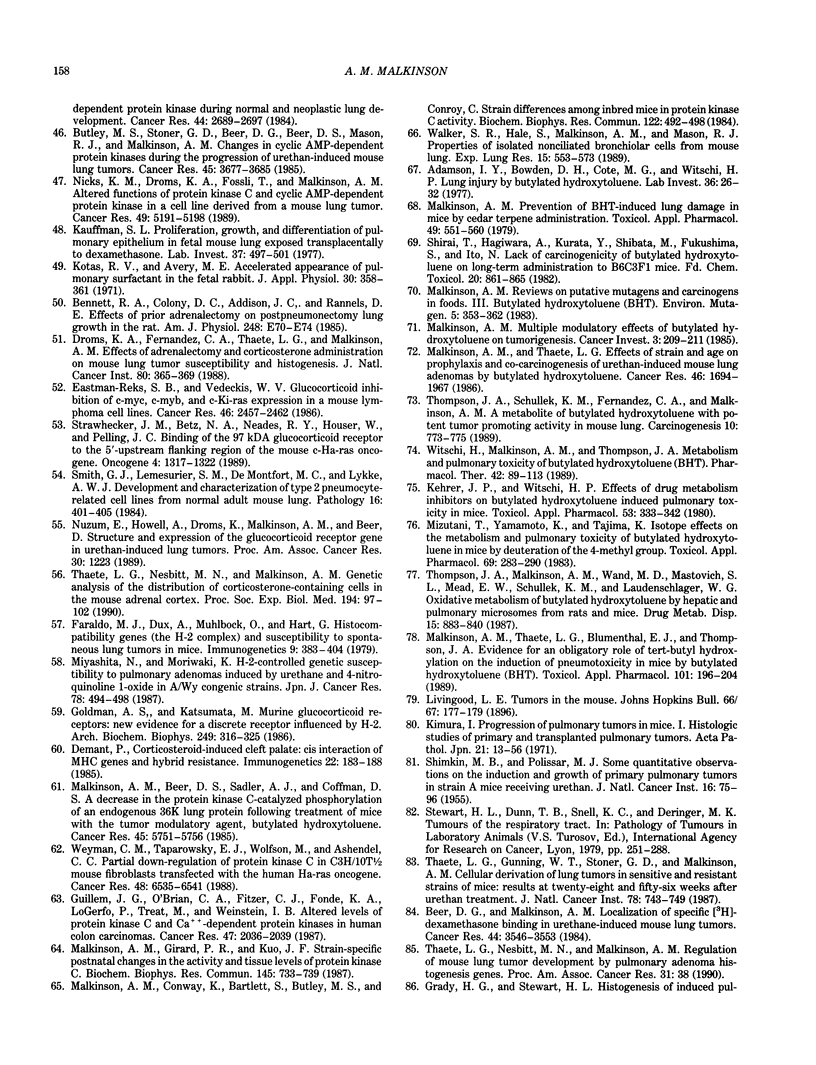
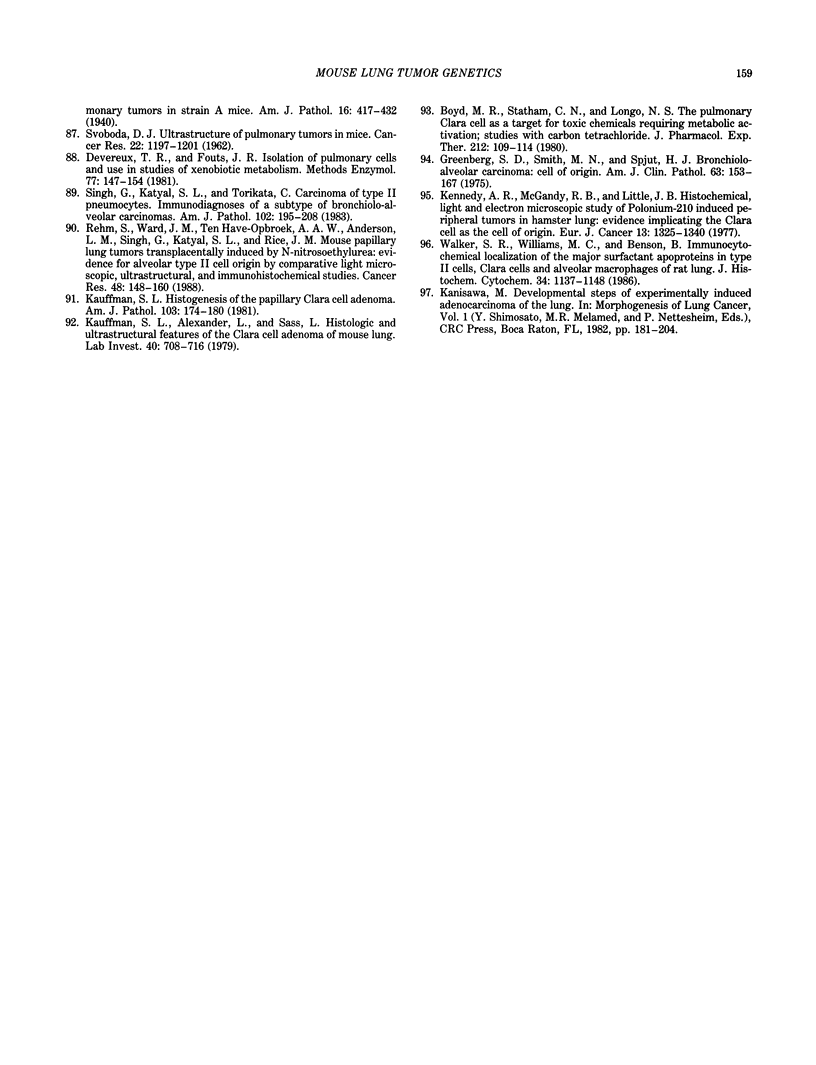
Images in this article
Selected References
These references are in PubMed. This may not be the complete list of references from this article.
- Adamson I. Y., Bowden D. H., Cote M. G., Witschi H. Lung injury induced by butylated hydroxytoluene: cytodynamic and biochemical studies in mice. Lab Invest. 1977 Jan;36(1):26–32. [PubMed] [Google Scholar]
- Adamson I. Y., Bowden D. H. The type 2 cell as progenitor of alveolar epithelial regeneration. A cytodynamic study in mice after exposure to oxygen. Lab Invest. 1974 Jan;30(1):35–42. [PubMed] [Google Scholar]
- BLOOM J. L., FALCONER D. S. A GENE WITH MAJOR EFFECT ON SUSCEPTIBILITY TO INDUCED LUNG TUMORS IN MICE. J Natl Cancer Inst. 1964 Oct;33:607–618. [PubMed] [Google Scholar]
- Bailey D. W. Recombinant-inbred strains. An aid to finding identity, linkage, and function of histocompatibility and other genes. Transplantation. 1971 Mar;11(3):325–327. doi: 10.1097/00007890-197103000-00013. [DOI] [PubMed] [Google Scholar]
- Beer D. G., Malkinson A. M. Localization of specific [3H]dexamethasone binding in urethan-induced mouse lung tumors. Cancer Res. 1984 Aug;44(8):3546–3553. [PubMed] [Google Scholar]
- Bennett R. A., Colony P. C., Addison J. L., Rannels D. E. Effects of prior adrenalectomy on postpneumonectomy lung growth in the rat. Am J Physiol. 1985 Jan;248(1 Pt 1):E70–E74. doi: 10.1152/ajpendo.1985.248.1.E70. [DOI] [PubMed] [Google Scholar]
- Bos J. L. ras oncogenes in human cancer: a review. Cancer Res. 1989 Sep 1;49(17):4682–4689. [PubMed] [Google Scholar]
- Boyd M. R., Statham C. N., Longo N. S. The pulmonary clara cell as a target for toxic chemicals requiring metabolic activation; studies with carbon tetrachloride. J Pharmacol Exp Ther. 1980 Jan;212(1):109–114. [PubMed] [Google Scholar]
- Butley M. S., Beer D. G., Malkinson A. M. Functional changes in the regulatory subunit of the type II cyclic adenosine 3':5'-monophosphate-dependent protein kinase isozyme during normal and neoplastic lung development. Cancer Res. 1984 Jun;44(6):2689–2697. [PubMed] [Google Scholar]
- Butley M. S., Stoner G. D., Beer D. G., Beer D. S., Mason R. J., Malkinson A. M. Changes in cyclic adenosine 3':5'-monophosphate-dependent protein kinases during the progression of urethan-induced mouse lung tumors. Cancer Res. 1985 Aug;45(8):3677–3685. [PubMed] [Google Scholar]
- Demant P., Oomen L. C., Oudshoorn-Snoek M. Genetics of tumor susceptibility in the mouse: MHC and non-MHC genes. Adv Cancer Res. 1989;53:117–179. doi: 10.1016/s0065-230x(08)60281-x. [DOI] [PubMed] [Google Scholar]
- Deschner E. E., Long F. C., Hakissian M., Herrmann S. L. Differential susceptibility of AKR, C57BL/6J, and CF1 mice to 1,2-dimethylhydrazine-induced colonic tumor formation predicted by proliferative characteristics of colonic epithelial cells. J Natl Cancer Inst. 1983 Feb;70(2):279–282. [PubMed] [Google Scholar]
- Devereux T. R., Fouts J. R. Isolation of pulmonary cells and use in studies of xenobiotic metabolism. Methods Enzymol. 1981;77:147–154. doi: 10.1016/s0076-6879(81)77019-8. [DOI] [PubMed] [Google Scholar]
- Droms K. A., Fernandez C. A., Thaete L. G., Malkinson A. M. Effects of adrenalectomy and corticosterone administration on mouse lung tumor susceptibility and histogenesis. J Natl Cancer Inst. 1988 May 4;80(5):365–369. doi: 10.1093/jnci/80.5.365. [DOI] [PubMed] [Google Scholar]
- Droms K. A., Haley B. E., Malkinson A. M. Decreased incorporation of the photoaffinity probe 8N3-[gamma-32P]-GTP into a 45kD protein in lung tumors. Biochem Biophys Res Commun. 1987 Apr 29;144(2):591–597. doi: 10.1016/s0006-291x(87)80007-4. [DOI] [PubMed] [Google Scholar]
- Droms K. A., Haley B. E., Smith G. J., Malkinson A. M. Decreased 8N3-[gamma-32P]GTP photolabeling of Gs alpha in tumorigenic lung epithelial cell lines: association with decreased hormone responsiveness and loss of contact-inhibited growth. Exp Cell Res. 1989 Jun;182(2):330–339. doi: 10.1016/0014-4827(89)90238-3. [DOI] [PubMed] [Google Scholar]
- Démant P. Corticosteroid-induced cleft palate: cis interaction of MHC genes and hybrid resistance. Immunogenetics. 1985;22(2):183–188. doi: 10.1007/BF00563516. [DOI] [PubMed] [Google Scholar]
- Eastman-Reks S. B., Vedeckis W. V. Glucocorticoid inhibition of c-myc, c-myb, and c-Ki-ras expression in a mouse lymphoma cell line. Cancer Res. 1986 May;46(5):2457–2462. [PubMed] [Google Scholar]
- Evans M. J., Johnson L. V., Stephens R. J., Freeman G. Renewal of the terminal bronchiolar epithelium in the rat following exposure to NO2 or O3. Lab Invest. 1976 Sep;35(3):246–257. [PubMed] [Google Scholar]
- Gazdar A. F., Linnoila R. I. The pathology of lung cancer--changing concepts and newer diagnostic techniques. Semin Oncol. 1988 Jun;15(3):215–225. [PubMed] [Google Scholar]
- Goldman A. S., Katsumata M. Murine glucocorticoid receptors: new evidence for a discrete receptor influenced by H-2. Arch Biochem Biophys. 1986 Sep;249(2):316–325. doi: 10.1016/0003-9861(86)90008-1. [DOI] [PubMed] [Google Scholar]
- Grady H. G., Stewart H. L. Histogenesis of induced pulmonary tumors in strain a mice. Am J Pathol. 1940 Jul;16(4):417–432.5. [PMC free article] [PubMed] [Google Scholar]
- Greenberg S. D., Smith M. N., Spjut H. J. Bronchiolo-alveolar carcinoma-cell of origin. Am J Clin Pathol. 1975 Feb;63(2):153–167. doi: 10.1093/ajcp/63.2.153. [DOI] [PubMed] [Google Scholar]
- Guillem J. G., O'Brian C. A., Fitzer C. J., Forde K. A., LoGerfo P., Treat M., Weinstein I. B. Altered levels of protein kinase C and Ca2+-dependent protein kinases in human colon carcinomas. Cancer Res. 1987 Apr 15;47(8):2036–2039. [PubMed] [Google Scholar]
- Hakkinen P. J., Haschek W. M. Pulmonary toxicity of methylcyclopentadienyl manganese tricarbonyl: nonciliated bronchiolar epithelial (Clara) cell necrosis and alveolar damage in the mouse, rat, and hamster. Toxicol Appl Pharmacol. 1982 Aug;65(1):11–22. doi: 10.1016/0041-008x(82)90357-x. [DOI] [PubMed] [Google Scholar]
- Inui T., Tsubura A., Morii S. Incidence of precancerous foci of mammary glands and growth rate of transplantable mammary cancers in sialoadenectomized mice. J Natl Cancer Inst. 1989 Nov 1;81(21):1660–1663. doi: 10.1093/jnci/81.21.1660. [DOI] [PubMed] [Google Scholar]
- Jetten A. M., Shirley J. E., Stoner G. Regulation of proliferation and differentiation of respiratory tract epithelial cells by TGF beta. Exp Cell Res. 1986 Dec;167(2):539–549. doi: 10.1016/0014-4827(86)90193-x. [DOI] [PubMed] [Google Scholar]
- Joishy S. K., Cooper R. A., Rowley P. T. Alveolar cell carcinoma in identical twins. Similarity in time of onset, histochemistry, and site of metastasis. Ann Intern Med. 1977 Oct;87(4):447–450. doi: 10.7326/0003-4819-87-4-447. [DOI] [PubMed] [Google Scholar]
- Kauffman S. L., Alexander L., Sass L. Histologic and ultrastructural features of the clara cell adenoma of the mouse lung. Lab Invest. 1979 Jun;40(6):708–716. [PubMed] [Google Scholar]
- Kauffman S. L. Histogenesis of the papillary Clara cell adenoma. Am J Pathol. 1981 May;103(2):174–180. [PMC free article] [PubMed] [Google Scholar]
- Kauffman S. L. Proliferation, growth, and differentiation of pulmonary epithelium in fetal mouse lung exposed transplacentally to dexamethasone. Lab Invest. 1977 Nov;37(5):497–501. [PubMed] [Google Scholar]
- Kehrer J. P., Witschi H. Effects of drug metabolism inhibitors on butylated hydroxytoluene-induced pulmonary toxicity in mice. Toxicol Appl Pharmacol. 1980 Apr;53(2):333–342. doi: 10.1016/0041-008x(80)90434-2. [DOI] [PubMed] [Google Scholar]
- Kennedy A. R., McGandy R. B., Little J. B. Histochemical, light and electron microscopic study of polonium-210 induced peripheral tumors in hamster lungs: evidence implicating the Clara cell as the cell of origin. Eur J Cancer. 1977 Nov;13(11):1325–1340. doi: 10.1016/0014-2964(77)90043-3. [DOI] [PubMed] [Google Scholar]
- Kimura K. Progression of pulmonary tumor in mice. 1. Histological studies of primary and transplanted pulmonary tumors. Acta Pathol Jpn. 1971 Feb;21(1):13–56. doi: 10.1111/j.1440-1827.1971.tb00108.x. [DOI] [PubMed] [Google Scholar]
- Kotas R. V., Avery M. E. Accelerated appearance of pulmonary surfactant in the fetal rabbit. J Appl Physiol. 1971 Mar;30(3):358–361. doi: 10.1152/jappl.1971.30.3.358. [DOI] [PubMed] [Google Scholar]
- Lange-Carter C. A., Fossli T., Jahnsen T., Malkinson A. M. Decreased expression of the type I isozyme of cAMP-dependent protein kinase in tumor cell lines of lung epithelial origin. J Biol Chem. 1990 May 15;265(14):7814–7818. [PubMed] [Google Scholar]
- Malkinson A. M., Beer D. S. Major effect on susceptibility to urethan-induced pulmonary adenoma by a single gene in BALB/cBy mice. J Natl Cancer Inst. 1983 May;70(5):931–936. [PubMed] [Google Scholar]
- Malkinson A. M., Beer D. S. Pharmacologic and genetic studies on the modulatory effects of butylated hydroxytoluene on mouse lung adenoma formation. J Natl Cancer Inst. 1984 Oct;73(4):925–933. [PubMed] [Google Scholar]
- Malkinson A. M., Beer D. S., Sadler A. J., Coffman D. S. Decrease in the protein kinase C-catalyzed phosphorylation of an endogenous lung protein (Mr 36,000) following treatment of mice with the tumor-modulatory agent butylated hydroxytoluene. Cancer Res. 1985 Nov;45(11 Pt 2):5751–5756. [PubMed] [Google Scholar]
- Malkinson A. M., Butley M. S. Alterations in cyclic adenosine 3':5'-monophosphate-dependent protein kinases during normal and neoplastic lung development. Cancer Res. 1981 Apr;41(4):1334–1344. [PubMed] [Google Scholar]
- Malkinson A. M., Conway K., Bartlett S., Butley M. S., Conroy C. Strain differences among inbred mice in protein kinase C activity. Biochem Biophys Res Commun. 1984 Jul 31;122(2):492–498. doi: 10.1016/s0006-291x(84)80060-1. [DOI] [PubMed] [Google Scholar]
- Malkinson A. M., Girard P. R., Kuo J. F. Strain-specific postnatal changes in the activity and tissue levels of protein kinase C. Biochem Biophys Res Commun. 1987 Jun 15;145(2):733–739. doi: 10.1016/0006-291x(87)91026-6. [DOI] [PubMed] [Google Scholar]
- Malkinson A. M. Multiple modulatory effects of butylated hydroxytoluene on tumorigenesis. Cancer Invest. 1985;3(2):209–211. doi: 10.3109/07357908509017505. [DOI] [PubMed] [Google Scholar]
- Malkinson A. M., Nesbitt M. N., Skamene E. Susceptibility to urethan-induced pulmonary adenomas between A/J and C57BL/6J mice: use of AXB and BXA recombinant inbred lines indicating a three-locus genetic model. J Natl Cancer Inst. 1985 Nov;75(5):971–974. doi: 10.1093/jnci/75.5.971. [DOI] [PubMed] [Google Scholar]
- Malkinson A. M. Prevention of butylated hydroxytoluene-induced lung damage in mice by cedar terpene administration. Toxicol Appl Pharmacol. 1979 Jul;49(3):551–560. doi: 10.1016/0041-008x(79)90457-5. [DOI] [PubMed] [Google Scholar]
- Malkinson A. M. Review: putative mutagens and carcinogens in foods. III. Butylated hydroxytoluene (BHT). Environ Mutagen. 1983;5(3):353–362. doi: 10.1002/em.2860050313. [DOI] [PubMed] [Google Scholar]
- Malkinson A. M., Thaete L. G., Blumenthal E. J., Thompson J. A. Evidence for a role of tert-butyl hydroxylation in the induction of pneumotoxicity in mice by butylated hydroxytoluene. Toxicol Appl Pharmacol. 1989 Nov;101(2):196–204. doi: 10.1016/0041-008x(89)90269-x. [DOI] [PubMed] [Google Scholar]
- Malkinson A. M., Thaete L. G. Effects of strain and age on prophylaxis and co-carcinogenesis of urethan-induced mouse lung adenomas by butylated hydroxytoluene. Cancer Res. 1986 Apr;46(4 Pt 1):1694–1697. [PubMed] [Google Scholar]
- Malkinson A. M. The genetic basis of susceptibility to lung tumors in mice. Toxicology. 1989 Mar;54(3):241–271. doi: 10.1016/0300-483x(89)90062-0. [DOI] [PubMed] [Google Scholar]
- Miyashita N., Moriwaki K. H-2-controlled genetic susceptibility to pulmonary adenomas induced by urethane and 4-nitroquinoline 1-oxide in A/Wy congenic strains. Jpn J Cancer Res. 1987 May;78(5):494–498. [PubMed] [Google Scholar]
- Mizutani T., Yamamoto K., Tajima K. Isotope effects on the metabolism and pulmonary toxicity of butylated hydroxytoluene in mice by deuteration of the 4-methyl group. Toxicol Appl Pharmacol. 1983 Jun 30;69(2):283–290. doi: 10.1016/0041-008x(83)90310-1. [DOI] [PubMed] [Google Scholar]
- Nesbitt M. N., Skamene E. Recombinant inbred mouse strains derived from A/J and C57BL/6J: a tool for the study of genetic mechanisms in host resistance to infection and malignancy. J Leukoc Biol. 1984 Sep;36(3):357–364. doi: 10.1002/jlb.36.3.357. [DOI] [PubMed] [Google Scholar]
- Nicks K. M., Droms K. A., Fossli T., Smith G. J., Malkinson A. M. Altered function of protein kinase C and cyclic adenosine monophosphate-dependent protein kinase in a cell line derived from a mouse lung papillary tumor. Cancer Res. 1989 Sep 15;49(18):5191–5198. [PubMed] [Google Scholar]
- Prelich G., Tan C. K., Kostura M., Mathews M. B., So A. G., Downey K. M., Stillman B. Functional identity of proliferating cell nuclear antigen and a DNA polymerase-delta auxiliary protein. Nature. 1987 Apr 2;326(6112):517–520. doi: 10.1038/326517a0. [DOI] [PubMed] [Google Scholar]
- Rehm S., Ward J. M., ten Have-Opbroek A. A., Anderson L. M., Singh G., Katyal S. L., Rice J. M. Mouse papillary lung tumors transplacentally induced by N-nitrosoethylurea: evidence for alveolar type II cell origin by comparative light microscopic, ultrastructural, and immunohistochemical studies. Cancer Res. 1988 Jan 1;48(1):148–160. [PubMed] [Google Scholar]
- Ryan J., Barker P. E., Nesbitt M. N., Ruddle F. H. KRAS2 as a genetic marker for lung tumor susceptibility in inbred mice. J Natl Cancer Inst. 1987 Dec;79(6):1351–1357. [PubMed] [Google Scholar]
- SHIMKIN M. B., POLISSAR M. J. Some quantitative observations on the induction and growth of primary pulmonary tumors in strain A mice receiving urethan. J Natl Cancer Inst. 1955 Aug;16(1):75–97. [PubMed] [Google Scholar]
- SVOBODA D. J. Ultrastructure of pulmonary adenomas in mice. Cancer Res. 1962 Nov;22:1197–1201. [PubMed] [Google Scholar]
- Sandgren E. P., Quaife C. J., Pinkert C. A., Palmiter R. D., Brinster R. L. Oncogene-induced liver neoplasia in transgenic mice. Oncogene. 1989 Jun;4(6):715–724. [PubMed] [Google Scholar]
- Shimkin M. B., Sasaki T., McDonough M., Baserga R., Thatcher D., Wieder R. Relation of thymidine index to pulmonary tumor response in mice receiving urethan and other carcinogens. Cancer Res. 1969 May;29(5):994–998. [PubMed] [Google Scholar]
- Shirai T., Hagiwara A., Kurata Y., Shibata M., Fukushima S., Ito N. Lack of carcinogenicity of butylated hydroxytoluene on long-term administration to B6C3F1 mice. Food Chem Toxicol. 1982 Dec;20(6):861–865. doi: 10.1016/s0015-6264(82)80219-8. [DOI] [PubMed] [Google Scholar]
- Singh G., Katyal S. L., Torikata C. Carcinoma of type II pneumocytes: immunodiagnosis of a subtype of "bronchioloalveolar carcinomas". Am J Pathol. 1981 Feb;102(2):195–208. [PMC free article] [PubMed] [Google Scholar]
- Sinn E., Muller W., Pattengale P., Tepler I., Wallace R., Leder P. Coexpression of MMTV/v-Ha-ras and MMTV/c-myc genes in transgenic mice: synergistic action of oncogenes in vivo. Cell. 1987 May 22;49(4):465–475. doi: 10.1016/0092-8674(87)90449-1. [DOI] [PubMed] [Google Scholar]
- Smith G. J., Le Mesurier S. M., de Montfort M. L., Lykke A. W. Development and characterization of type 2 pneumocyte-related cell lines from normal adult mouse lung. Pathology. 1984 Oct;16(4):401–405. doi: 10.3109/00313028409084730. [DOI] [PubMed] [Google Scholar]
- Solt D. B., Medline A., Farber E. Rapid emergence of carcinogen-induced hyperplastic lesions in a new model for the sequential analysis of liver carcinogenesis. Am J Pathol. 1977 Sep;88(3):595–618. [PMC free article] [PubMed] [Google Scholar]
- Stewart H. L., Dunn T. B., Snell K. C., Deringer M. K. Tumours of the respiratory tract. IARC Sci Publ. 1979;23:251–287. [PubMed] [Google Scholar]
- Strawhecker J. M., Betz N. A., Neades R. Y., Houser W., Pelling J. C. Binding of the 97 kDa glucocorticoid receptor to the 5' upstream flanking region of the mouse c-Ha-ras oncogene. Oncogene. 1989 Nov;4(11):1317–1322. [PubMed] [Google Scholar]
- Suda Y., Aizawa S., Hirai S., Inoue T., Furuta Y., Suzuki M., Hirohashi S., Ikawa Y. Driven by the same Ig enhancer and SV40 T promoter ras induced lung adenomatous tumors, myc induced pre-B cell lymphomas and SV40 large T gene a variety of tumors in transgenic mice. EMBO J. 1987 Dec 20;6(13):4055–4065. doi: 10.1002/j.1460-2075.1987.tb02751.x. [DOI] [PMC free article] [PubMed] [Google Scholar]
- Terzaghi-Howe M. Changes in response to, and production of, transforming growth factor type beta during neoplastic progression in cultured rat tracheal epithelial cells. Carcinogenesis. 1989 Jun;10(6):973–980. doi: 10.1093/carcin/10.6.973. [DOI] [PubMed] [Google Scholar]
- Thaete L. G., Ahnen D. J., Malkinson A. M. Proliferating cell nuclear antigen (PCNA/cyclin) immunocytochemistry as a labeling index in mouse lung tissues. Cell Tissue Res. 1989 Apr;256(1):167–173. doi: 10.1007/BF00224731. [DOI] [PubMed] [Google Scholar]
- Thaete L. G., Beer D. G., Malkinson A. M. Genetic variation in the proliferation of murine pulmonary type II cells: basal rates and alterations following urethan treatment. Cancer Res. 1986 Oct;46(10):5335–5338. [PubMed] [Google Scholar]
- Thaete L. G., Gunning W. T., Stoner G. D., Malkinson A. M. Cellular derivation of lung tumors in sensitive and resistant strains of mice: results at 28 and 56 weeks after urethan treatment. J Natl Cancer Inst. 1987 Apr;78(4):743–749. [PubMed] [Google Scholar]
- Thaete L. G., Nesbitt M. N., Malkinson A. M. Genetic analysis of the distribution of corticosterone-containing cells in mouse adrenal cortex. Proc Soc Exp Biol Med. 1990 Jun;194(2):97–102. doi: 10.3181/00379727-194-43062. [DOI] [PubMed] [Google Scholar]
- Thompson J. A., Schullek K. M., Fernandez C. A., Malkinson A. M. A metabolite of butylated hydroxytoluene with potent tumor-promoting activity in mouse lung. Carcinogenesis. 1989 Apr;10(4):773–775. doi: 10.1093/carcin/10.4.773. [DOI] [PubMed] [Google Scholar]
- Walker S. R., Hale S., Malkinson A. M., Mason R. J. Properties of isolated nonciliated bronchiolar cells from mouse lung. Exp Lung Res. 1989 Jul;15(4):553–573. doi: 10.3109/01902148909069618. [DOI] [PubMed] [Google Scholar]
- Walker S. R., Williams M. C., Benson B. Immunocytochemical localization of the major surfactant apoproteins in type II cells, Clara cells, and alveolar macrophages of rat lung. J Histochem Cytochem. 1986 Sep;34(9):1137–1148. doi: 10.1177/34.9.2426341. [DOI] [PubMed] [Google Scholar]
- Weyman C. M., Taparowsky E. J., Wolfson M., Ashendel C. L. Partial down-regulation of protein kinase C in C3H 10T 1/2 mouse fibroblasts transfected with the human Ha-ras oncogene. Cancer Res. 1988 Nov 15;48(22):6535–6541. [PubMed] [Google Scholar]
- Wheeler G. P., Alexander J. A. Rate of DNA synthesis as an indication of drug toxicity and as a guide for scheduling cancer therapy. Cancer Treat Rep. 1978 May;62(5):755–769. [PubMed] [Google Scholar]
- Witschi H. P. Enhancement of tumor formation in mouse lung by dietary butylated hydroxytoluene. Toxicology. 1981;21(2):95–104. doi: 10.1016/0300-483x(81)90120-7. [DOI] [PubMed] [Google Scholar]
- Witschi H. P., Morse C. C. Cell kinetics in mouse lung following administration of carcinogens and butylated hydroxytoluene. Toxicol Appl Pharmacol. 1985 May;78(3):464–472. doi: 10.1016/0041-008x(85)90254-6. [DOI] [PubMed] [Google Scholar]
- Witschi H., Malkinson A. M., Thompson J. A. Metabolism and pulmonary toxicity of butylated hydroxytoluene (BHT). Pharmacol Ther. 1989;42(1):89–113. doi: 10.1016/0163-7258(89)90023-5. [DOI] [PubMed] [Google Scholar]
- You M., Candrian U., Maronpot R. R., Stoner G. D., Anderson M. W. Activation of the Ki-ras protooncogene in spontaneously occurring and chemically induced lung tumors of the strain A mouse. Proc Natl Acad Sci U S A. 1989 May;86(9):3070–3074. doi: 10.1073/pnas.86.9.3070. [DOI] [PMC free article] [PubMed] [Google Scholar]
- de Larco J. E., Todaro G. J. Growth factors from murine sarcoma virus-transformed cells. Proc Natl Acad Sci U S A. 1978 Aug;75(8):4001–4005. doi: 10.1073/pnas.75.8.4001. [DOI] [PMC free article] [PubMed] [Google Scholar]
- de Munter H. K., den Engelse L., Emmelot P. Studies on lung tumours. IV. Correlation between [3H]thymidine labelling of lung and liver cells and tumour formation in GRS/A and C3Hf/A male mice following administration of dimethylnitrosamine. Chem Biol Interact. 1979 Mar;24(3):299–316. doi: 10.1016/0009-2797(79)90079-6. [DOI] [PubMed] [Google Scholar]



